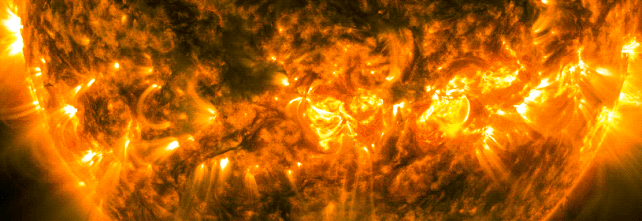The Sun just unleashed the most powerful flare we've seen in seven years.On October 3, a flare measured at a strength of X9.0 exploded right in the middle of the solar disk. Even more excitingly, it was accompanied by what is known as a halo coronal mass ejection – one that is ejected straight at Earth.
It's the second X-class flare of October 2024, both emitted from the same active sunspot region, and the most powerful since September 2017, when the Sun unleashed a ripper, later determined to clock in at X11.88.
Solar flares are currently rampant because the Sun is in the peak of its 11-year activity cycle, letting them off daily since early 2022. Most of the flares are smaller explosions, but we're definitely seeing an uptick in X-class flares, the most powerful category that we can measure.
The X9.0 of October 3 is among the top 20 most powerful flares on record.

It erupted from a sunspot region called AR 3842, which has a particularly complex magnetic configuration referred to as a 'Beta-Gamma-Delta' classification.
Sunspots are spots on the Sun where the magnetic field is temporarily stronger. They're also magnetically messy; magnetic field lines of opposite polarity can tangle, snap, and reconnect. This reconnection unleashes a burst of energy – a solar flare.
Beta-Gamma sunspot regions contain zones of opposing polarity that don't easily connect. Deltas have opposing polarities crammed into a smaller space, which raises the chances the whole spot will become a region of repeat, intense activity. This is what we're seeing now with AR 3842. On October 1, it unleashed an X7.1 flare. Then it upped the ante with the X9.0.
Solar flares can be disruptive to Earth. We're safe here on the surface, since X- and gamma radiation can't travel far into the atmosphere; but the powerful burst of radiation can briefly interfere with high-frequency radio communications systems.
The strongest effects are felt with a coronal mass ejection, or CME. These often – but not always – occur with solar flares.
An expulsion of billions of tons of solar particles and tangled magnetic fields that blast through the Solar System, CMEs can take a few days to reach us, but when they do, the particles interact with Earth's magnetosphere to power a geomagnetic storm, with several consequences.
Electric currents generated high up in the atmosphere can result in power grid fluctuations, and voltage corrections may need to be applied, for example. There is increased drag on satellites, which can require course correction. Satellite communications and GPS can be disrupted.
For a single CME, even one accompanying a powerful flare, the effects are unlikely to cause too many problems, but we are likely to see auroras, down as far 50 degrees latitude.
Auroras are caused by solar particles slamming into Earth's magnetic field, and getting channeled and accelerated along magnetic field lines to high latitudes, where they are dumped out into the upper atmosphere.
Their interactions with particles in the atmosphere result in ionization, which causes it to glow in colors that vary depending on the ratio of elements in the atmosphere. It's pretty much the same mechanism behind energizing neon in fluorescent lights, just on a much, much bigger scale.
We were already on aurora alert from the X7.1 flare and CME that accompanied it. A halo CME is one that is directed right at Earth; we're going to catch the brunt of it, and the NOAA is forecasting several days of peak aurora conditions.
Some of the most powerful geomagnetic storms are the result of a cannibal CME, where two CMEs are released in relatively quick succession, and the second overtakes and engulfs the first for a giant influx of solar particles. The two CMEs we're expecting now were released days apart, so we're probably not going to see that here.
But conditions for aurora are strong, and will remain so through the weekend. It might be time to plan some skywatching to catch one of the most glorious shows our planet has to offer.















No comments